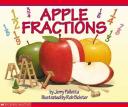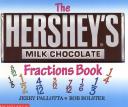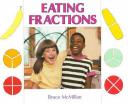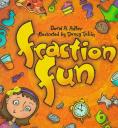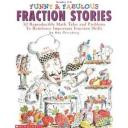This blog post addresses books, websites and additional resources that align with the third grade standard of learning 3.3. In this SOL, students should learn how to divide up objects and sets to represent fractions and mixed numbers and write the names of fractions and mixed numbers. Additionally, students should compare fractions using the greater than, less than or equal to signs. Many of the books on fractions are intended as a review, or an introduction to a fraction lesson, while the additional resources and websites tend to be more complex and focus on more difficult fractions. Books
By Jerry Pallotta and Illustrated by Rob Bolster
Apple Fractions introduces students to the world of fractions through a simple visual tool, the apple. This book discusses fractions based around dividing an apple up into eight parts. It uses and mentions specific apple types (like Golden Delicious and GrannySmith) in its realistic illustrations. This book is a simple way for students to understand beginning fractions like 1/2, 1/4, 1/6 and so on.
The Hershey’s Milk Chocolate Bar Fraction Book
By Jerry Pallotta and Illustrated by Rob Bolster
This book, written and illustrated by the same people who brought you Apple Fractions, uses a Hershey’s chocolate bar as a template for learning fractions. Hershey’s bars make for an easy fractions lesson because they come already divided up into 12 parts. This book compares various twelfths to the whole bar and even introduces beginning fraction adding and subtracting. This book would be a great resources for a classroom because, like the Apple Fractions book, this book could easily turn into a classroom activity using the same manipulative that the book uses (a candy bar, or an apple).
By Bruce McMillan
Eating Fractions takes the concept of using food to discuss fractions a step further in that it uses a variety of different foods that students could encounter throughout the day. This book is unique in that it is a departure from the standard pizza or pie fraction model and instead uses foods like corn, bananas and other non-standard fraction shapes. Through his photographs, McMillan demonstrates halves, thirds and fourths in a simple, fun and easy to understand layout and storyline.
By Loreen Leedy
Fraction Action describes a teacher teaching her classroom about introductory fractions. Students learn about basic fractions like 1/2, 1/3 and 1/4 using drawings of pies and pizzas, but the unique thing about this book is that it also addresses part of a set fractions. Students learn along with the class of children (animals) in Fraction Action which combines humor, a few do it yourself problems and fun illustrations to explain basic fractions.
By David A. Adler and Illustrated by Nancy Tobin
Fraction Fun is more explanatory than most fraction books. It provides an easy to understand definition of fractions and explains it using the typical pizza explanation, but diverts from that visual by also discussing coins and their fractional values in terms of weight and monetary value. This book is therefore intended for an older audience who would have some knowledge of weights and money, but could easily be understood, and enjoyed, by most third graders because of the simple explanations and fun illustrations.
Websites
Mrs. Thonus’ Third Grade Stars- Fraction Fun
This website, designed and produced by a third grade teacher, provides fun websites and activities for students who are learning about fractions. She provides a link to a powerpoint about fractions and links to some online fraction games. These links cover a range of fraction topics such as identifying and naming fractions, comparing fractions and beginning adding fractions. This websites is very clear and easy to navigate and would be perfect for students looking for fraction activities to do online.
Zeebo is a little circle fraction drawing who explains fractions to students through his website. This website includes sections like “fractions, what are they?”, “fractions, mixed numbers”, “fractions, equivalent fractions” and many more sections icnreasing in difficulty. The first section, “fractions, what are they?” would be best for most third grade students, but the varying levels of difficulty on this site would be a good tool for differentiation. In the different sections Zeebo uses simple geometric graphics to explain the topic and asks students comprehension questions about the information that he has presented. This site is easy to navigate and provides excellent explanations of a sometimes tricky topic.
This website provides links to a plethora of fraction information and games. Topics on the site include fractions tutorials, Egyptian fractions, fraction games about pizza, soccer, shapes, cookies and much more. For older or more advanced students, the site has information on comparing and changing fractions to decimals. This website would be an excellent classroom resource because there are so many activities and online lessons for students to explore all from one centralized site. This site may be overwhelming though, so any student navigation of this site should be teacher led and guided.
Kids Online Resources- Fractions
This website is more of an online activity than an informational site. Students click on subsections like “what is a fraction?”, “fraction practice” and “equivalent fractions”. This website goes into more difficult fractions like fifths and sixths, in addition to the basic halves thirds and fourths. Students can do a tutorial about fractions and then practice their knowledge through an exploration of equivalent geometric shapes. This site uses bright colors, sounds and moving shapes to make learning about fractions interactive and fun.
This website, produced by the BBC, explains the concept of a fraction through words, pictures and numbers. It discusses equivalent fractions, converting fractions to decimals (for the older students), comparing fractions and improper and mixed fractions. There is also a fraction game that asks students to compare fractions with different denominators by ordering them in size, a game where students can create and play with making their own fractions of a cylinder, and a fractions quiz where students can test what they have just learned.
Additional Resources
This game asks students to name the fraction represented by a piece of pie. This game is a fun way for students to practice naming fractions; it provides supports and scaffolds for students who may need extra help by providing a simple picture and by giving students the total number of pieces to keep students from having to do too much counting and possibly getting confused.
Funny and Fabulous Fraction Stories
By Dan Greenburg and Jared Lee
This book uses humorous stories to introduce students to identifying and manipulating fractions. Some of the material in this book may be too complex for third grade students, such as the stories about changing fractions to decimals, adding, subtracting and dividing fractions and ratios of fractions. Many of the stories, however, are basic enough to be good for reinforcing students’ comfort with fractions. This book is a great way to learn across the curriculum since it combines funny and entertaining stories with math problems that students can do individually or as a class.
By Learning Resources
This kit comes with cardboard pizzas cut into slices to use as manipulatives in a variety of provided games designed to get kids to create fractions, compare equivalent fractions and beginning adding fractions. The pizzas are realistic and the games are easily adaptable for a many skill and grade levels so that this resource can be used over and over again as students learn more about fractions.
Shepherd Software Matching FractionsThis game asks students to match a written fraction with a picture and vice versa. It gets students to practice both naming and identifying fractions. The levels go up in difficulty from basic fractions like 1/2 and 1/5 to more difficult fractions like 7/8 to mixed fractions like 2 1/2. The simple graphics and clear directions make this a good activity for students to do as part of a center or on their own time.

